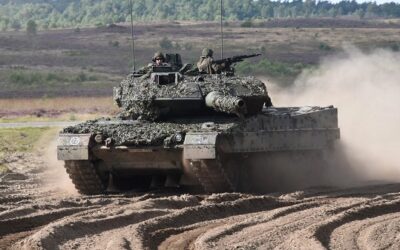Systems Feature Lighter Components and Lower-Cost Assemblies
MONCh recently had an opportunity to interview Dr Nissim Assida, Director of R&D and Engineering at Ophir Optronics Solutions Ltd. He answers questions that illuminate the arcane world of specialised optical systems.
MONCh: What is Ophir’s raison d’être in the defence and security sector? Who are its customers?
N. Assida: With over four decades of accumulated knowledge and know-how, Ophir is a leading designer and manufacturer of high-performance infrared thermal imaging lenses and optical elements. These are used in numerous homeland security and defence applications, including infrared observation systems, airborne systems such as unmanned aerial systems (UAS), driver vision enhancement systems, thermal weapon sights and a variety of handheld applications.
Advanced technology, innovative engineering and unique design configurations mean that Ophir can provide optics with fewer elements, increased efficiency, lighter-weight components and lower-cost assemblies.
Ophir’s customers are defence companies and systems integrators worldwide. Ophir is a significant resource for manufacturers of security and defence equipment requiring high-quality optical components, as it offers build-to-print services. IR components include aspheric, diffractive and spherical lenses, mirrors, windows and prisms.
MONCh: Why are multi-spectral optics important for today’s defence and national security sectors?
N. Assida: Over the last decade, multi-spectral optical systems have been used by system integrators in surveillance and monitoring and in certain commercial applications. Multi-spectral optics enable many new possibilities for defence and security missions, on land and at sea. They enable the combining of multiple cameras into one, significantly improving performance without increasing size or weight. These systems generally have long focal lengths and are meant for long-distance surveillance, possibly tens of kilometers. Multi-spectral optics enable maximum error correction and allow for a wider field of view, offering high performance across a wide range of wavelengths (short-, mid- and long-wave IR, visible and near IR). They allow for high day/night performance in situations in which vision is obscured, such as low lighting or adverse weather conditions.
For example, multi-spectral optics are integrated into the optical systems of large UAS for the long-distance aerial monitoring of agricultural field temperature using IR. They are also used in the aerospace industry for satellites and long-range telescopes.
MONCh: What are the challenges for increasing lens image accuracy, detail and quality?
N. Assida: Image quality is affected by all system components – lens, detector, electronics, image processing and monitor.
Lens-related image quality factors are diffraction limit, lens design and manufacturing tolerances.
Diffraction limit is a physical limit, which depends on the wavelength and F# only, not on the lens design or manufacturing process. The other two factors determine lens aberration, which limits image quality. There are several types of aberrations, each of which degrades image quality in a different way. An ideal lens eliminates all aberrations completely but, in reality, it is impossible and impractical to design and manufacture an aberration-free lens. In order to achieve high image quality, lens aberrations should be minimized – a challenging task, especially with the smaller pixel sizes of modern detectors, because there is a tradeoff between minimum lens aberration and reasonable cost.
The optical design specifies the layout of the optical elements, the raw material, shape and dimensions of each optical element, as well as tolerances for manufacturing and mounting. Theoretically, it is possible to minimise lens aberrations by adding more optical elements and specifying tight tolerances on lens manufacturing and assembly. This approach, however, would increase lens cost dramatically, making it too expensive for the market. The right approach is be to achieve a balance between lens performance and cost. Ophir has succeeded in achieving excellent lens performance, together with competitive prices, by combining an innovative well-experienced design team with superior in-house manufacturing capabilities.
MONCh: What are the limitations on reducing optical payloads to meet ever-demanding size, weight, and power consumption (SWaP) goals in small UAS? Has this sector hit a SWaP limit yet?
N. Assida: UAS payloads, especially for smaller commercial systems, impose strict size and weight restrictions. Power consumption must be reduced to minimise fuel usage, thus maximising flight time.
Optical payloads for small autonomous aerial systems must be able to provide high optical performance despite their compact form. Detectors are increasing in both resolution (number of pixels) and format (size), while decreasing in pixel size, which puts pressure on optical manufacturers to make smaller, lighter optics with lens quality that will still allow for maximum imaging performance.
Various technologies are being used to meet these needs. Solutions include innovative optical and mechanical designs, free-form optics, and unique lens coatings.
It is too soon to expect a SWaP Limit to have been reached: technology continues to evolve and progress with every year that passes. In the next ten years, we expect to see significant, continued improvements in R&D, in line with the ever-increasing SWaP goals.
MONCh: What role is played by large mirrors in long-range, multi-spectral optical systems? What are the challenges in using them?
N. Assida: Large mirrors are often integrated in the optical systems of defence and surveillance systems – for example, in large aircraft. These mirrors allow for high-resolution imagery during long-distance surveillance and monitoring missions. To produce high-quality images from a distance, the mirrors must meet a strict set of requirements. Detectors are increasing in resolution all the time, necessitating mirrors with increasingly accurate surfaces, meeting tight tolerances in terms of shape and irregularities. The multi-spectral nature of the optical systems means that mirrors must also be able to perform throughout a variety of wavelengths. They must have minimum roughness, especially when they are used in visible wavelength, under 40Å root mean square, to prevent light from scattering.
MONCh: Thank you.
























